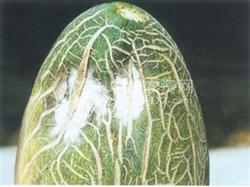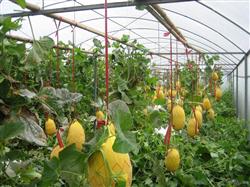Cantaloupe root knot nematode disease

Root-knot nematode disease is an important disease of Hami melon, which occurs and distributes in some areas. It can occur in protected and open fields. The disease is more serious in autumn. Infection in seedling stage has a great impact on production. After the disease, the rate of diseased plants is often more than 60%, which obviously affects the production of Hami melon. The symptoms are mainly harmful to the root system, producing many milky white root knots of different sizes on the main root and lateral root, and white translucent pear-shaped nematode can be seen by cutting open the root knot. In the later stage of the disease, the color of the diseased root became darker and finally rotted, and the aboveground part of the plant or seedling became lighter with the development of the disease, wilting gradually from the bottom up to all withered. The pathogen MeloidogyneincognitaChitwood is called southern root-knot nematode. The pathogenic nematodes are male and female, and the larvae are slender and wormlike. The male adult is linear, the tail end is slightly round, colorless and transparent, and the size is 1. 0-1.5mm × 0. 03-0.04mm. The female adult is pear-shaped, and each female nematode can lay 300,800 eggs and is buried in the host tissue, with a size of 0.44-1.59mm × 0.26-0.81mm. The disease characteristics of southern root-knot nematode can propagate and survive the winter on many kinds of vegetables in winter. In the northern vegetable area, nematodes overwintered mainly as oocysts excreted by female adults in the root knot in the protected soil. When the temperature rises, the overwintering eggs hatch into larvae, or some overwintering larvae continue to develop and move in the surface layer of the soil. When it comes to the host, it invades from the young roots, stimulating the host cells to divide and proliferate to form giant cells, and excessively divide to form nodular root knots. The larvae develop into adults in the root knot and begin to mate and lay eggs. The eggs hatched in the root knot, the 1st instar larvae remained in the eggs, and the 2nd instar larvae drilled out of the host for re-infection. It is mainly spread by diseased soil, diseased seedlings, watering and agricultural tools. Nematodes multiply quickly and are easy to accumulate in the soil under the conditions of 20-30 ℃ of soil temperature and 40% of humidity. In general, the land or shed with high topography, loose soil, and lack of water and fertilizer occurs heavier, usually the greenhouse is heavier than the greenhouse, and the greenhouse is heavier than the open field. In addition, the incidence of continuous cropping is more serious. Prevention and control methods (1) agricultural control. Raise seedlings in disease-free soil, choose insect-free soil or field soil to raise seedlings, apply organic fertilizer without disease residue or fully mature organic fertilizer, also use substrate to raise seedlings, and pay attention to prevent man-made transmission. After harvest, the seriously diseased land should thoroughly remove the diseased roots and residues, dig deep into the soil for 30-50cm, and disinfect insects by sunlight at the end of spring and the beginning of summer. That is to say, after ploughing and mixing with quicklime and shredded rice straw 4.5-7.5t/hm2 respectively, the soil nematodes, germs and weeds can be killed by digging ditches, ridging or making borders, filling with water, covering the plastic film and compacting, and then sealing the greenhouse for 10-15 days. Pay attention to the application of biological fertilizer after treatment. (2) Pesticide control. For soil treatment according to chemical properties before sowing or planting, 1.8% EC 10-15L/hm2 can be selected to evenly apply water to the seedbed, or to planting ditches or holes for re-sowing or planting. It is also possible to use 98% 100% 120kg/hm2 75-LV, spread evenly or ditch in the 20cm topsoil, immediately cover the soil, spray water to seal or cover the film for 7-12 days, loosen the soil for 3-10 days, and then sow or plant. It can also be evenly applied to the planting ditch with 22.5-30kg/hm2 3% milol granules.
- Prev

Fusarium oxysporum fruit rot of Hami melon
Fusarium fruit rot of Hami melon, also known as white mildew, is an important disease on Hami melon, which mostly occurs during storage and transportation, and Hami melon and Bailan melon are vulnerable. The symptoms are mainly harmful to the fruit. At the beginning of the fruit stalk produced a round slightly sunken light brown spot, the size of 10-30mm, waterlogged around the back, some slightly cracked, on the crack.
- Next

Key points of high-yield cultivation techniques of Hami melon
1. Sowing and cultivating strong seedlings at the right time from the end of December to the first ten days of January of the second year, with a seedling age of 30 days. Before sowing, the seeds were disinfected, soaked and germinated. Nutritious soil is selected from soil or paddy soil that has not been planted with melon crops. 2000 kg of rotten manure and 10 kg of calcium superphosphate are used as base fertilizer every 667m2. ...
Related
- Moge, come on! The staff of the peasant association in the producing area of cantaloupe were frightened when the crowd gathered.
- Causes and Solutions of low Fruit setting rate of Apple
- Symptoms and control measures of passion fruit virus disease
- Fruit growing lesson: how do apple orchards keep high yields?
- Can you build orchards in the mountains? What are the pros and cons?
- How to manage the coloring period of Crisson grape?
- This paper introduces the processing technology of two kinds of fig products.
- How much is a month for retired teachers in rural areas by 2020?
- How can strawberry planting increase sugar content? We should pay attention to management in many aspects.
- What are the cultivation techniques on how to improve the yield of golden fruit?

